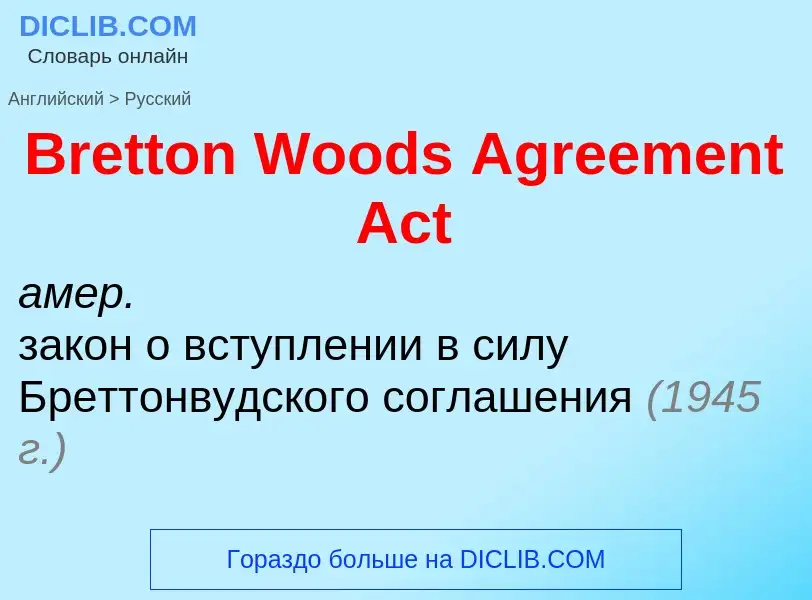Tradução e análise de palavras por inteligência artificial ChatGPT
Nesta página você pode obter uma análise detalhada de uma palavra ou frase, produzida usando a melhor tecnologia de inteligência artificial até o momento:
- como a palavra é usada
- frequência de uso
- é usado com mais frequência na fala oral ou escrita
- opções de tradução de palavras
- exemplos de uso (várias frases com tradução)
- etimologia
Bretton Woods Agreement Act - tradução para russo
закон о вступлении в силу Бреттонвудского соглашения (1945 г.)
Definição
Wikipédia

The Bretton Woods system of monetary management established the rules for commercial and financial relations among the United States, Canada, Western European countries, Australia, and Japan after the 1944 Bretton Woods Agreement. The Bretton Woods system was the first example of a fully negotiated monetary order intended to govern monetary relations among independent states. The Bretton Woods system required countries to guarantee convertibility of their currencies into U.S. dollars to within 1% of fixed parity rates, with the dollar convertible to gold bullion for foreign governments and central banks at US$35 per troy ounce of fine gold (or 0.88867 gram fine gold per dollar). It also envisioned greater cooperation among countries in order to prevent future competitive devaluations, and thus established the International Monetary Fund (IMF) to monitor exchange rates and lend reserve currencies to nations with balance of payments deficits.
Preparing to rebuild the international economic system while World War II was still being fought, 730 delegates from all 44 Allied nations gathered at the Mount Washington Hotel in Bretton Woods, New Hampshire, United States, for the United Nations Monetary and Financial Conference, also known as the Bretton Woods Conference. The delegates deliberated from 1 to 22 July 1944, and signed the Bretton Woods agreement on its final day. Setting up a system of rules, institutions, and procedures to regulate the international monetary system, these accords established the IMF and the International Bank for Reconstruction and Development (IBRD), which today is part of the World Bank Group. The United States, which controlled two-thirds of the world's gold, insisted that the Bretton Woods system rest on both gold and the US dollar. Soviet representatives attended the conference but later declined to ratify the final agreements, charging that the institutions they had created were "branches of Wall Street". These organizations became operational in 1945 after a sufficient number of countries had ratified the agreement. According to Barry Eichengreen, the Bretton Woods system operated successfully due to three factors: "low international capital mobility, tight financial regulation, and the dominant economic and financial position of the United States and the dollar."
On 15 August 1971, the United States terminated convertibility of the US dollar to gold, effectively bringing the Bretton Woods system to an end and rendering the dollar a fiat currency. Shortly thereafter, many fixed currencies (such as the pound sterling) also became free-floating, and the subsequent era has been characterized by floating exchange rates. The end of Bretton Woods was formally ratified by the Jamaica Accords in 1976.



![Newfoundland]] resulted in the [[Atlantic Charter]], which the U.S. and Britain officially announced two days later. Newfoundland]] resulted in the [[Atlantic Charter]], which the U.S. and Britain officially announced two days later.](https://commons.wikimedia.org/wiki/Special:FilePath/Prince of Wales-5.jpg?width=200)
![CHF]] exchange rate}}
CHF]] exchange rate}}](https://commons.wikimedia.org/wiki/Special:FilePath/US Dollar Index DXY.webp?width=200)
![[[John Maynard Keynes]] (right) and [[Harry Dexter White]] at the inaugural meeting of the International Monetary Fund's Board of Governors in Savannah, Georgia, U.S., 8 March 1946 [[John Maynard Keynes]] (right) and [[Harry Dexter White]] at the inaugural meeting of the International Monetary Fund's Board of Governors in Savannah, Georgia, U.S., 8 March 1946](https://commons.wikimedia.org/wiki/Special:FilePath/WhiteandKeynes.jpg?width=200)
